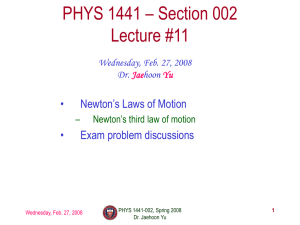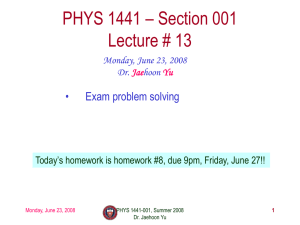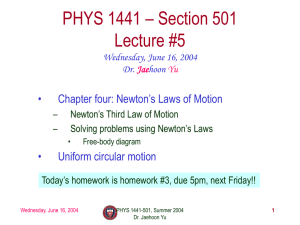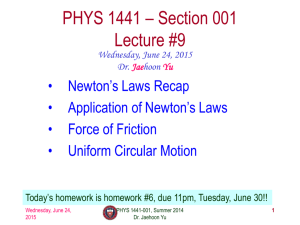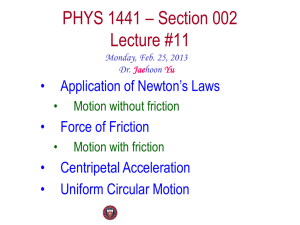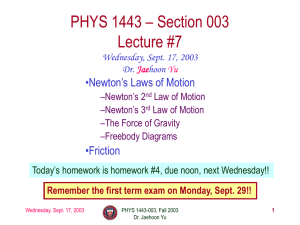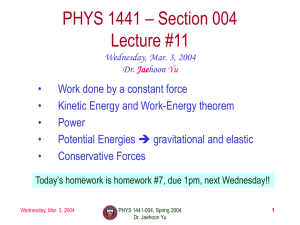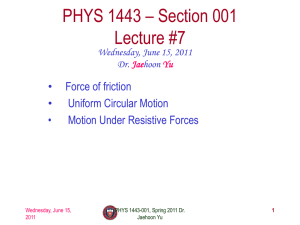Wednesday, June 18, 2014
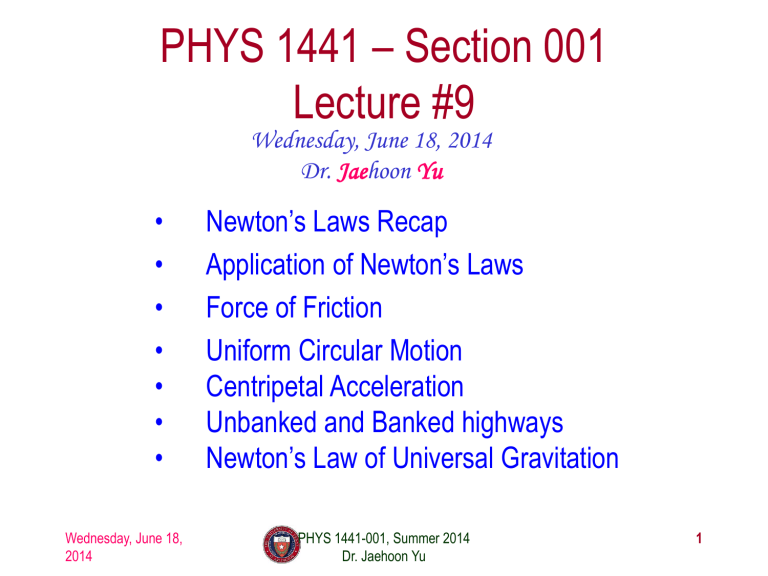
PHYS 1441 – Section 001
Lecture #9
Wednesday, June 18, 2014
Dr. Jae hoon Yu
• Newton’s Laws Recap
• Application of Newton’s Laws
• Force of Friction
• Uniform Circular Motion
• Centripetal Acceleration
• Unbanked and Banked highways
• Newton’s Law of Universal Gravitation
Wednesday, June 18,
2014
PHYS 1441-001, Summer 2014
Dr. Jaehoon Yu
1
Announcements
• Reading Assignments
– CH5 – 4 and 5 – 9
• Please make sure that you pay for Quest homework access today!!
– The deadline is tomorrow, Thursday, June 19!
– You will lose all access to your homework site and grades if you do not pay by June 19.
• 39 of you still haven’t paid!!
– NO extension for homework submission will be granted if you lose your access!!
• PLEASE do work on homework!
– It will be very hard to pass this course without doing homework since it is 25%(!!!) of the entire grade!!
Wednesday, June 18,
2014
PHYS 1441-001, Summer 2014
Dr. Jaehoon Yu
2
Special Project #3
• Using the fact that g=9.80m/s 2 on the Earth’s surface, find the average density of the Earth.
– Use the following information only but without computing the volume explicitly
• The gravitational constant
• The radius of the Earth
G
R
E
=
6.67
´
10
-
11
=
6.37
´
10
3
N
× m
2 km
• 20 point extra credit
• Due: Monday, June 23
• You must show your OWN, detailed work to obtain any credit!! kg
2
Wednesday, June 18,
2014
PHYS 1441-001, Summer 2014
Dr. Jaehoon Yu
3
Newton’s First Law and Inertial Frames
Aristotle (384-322BC): A natural state of a body is rest. Thus force is required to move an object. To move faster, ones needs larger forces.
Galileo ’ s statement on natural states of matter: Any velocity once imparted to a moving body will be rigidly maintained as long as the external causes of retardation are removed!!
Galileo’s statement is formulated by Newton into the 1 st law of motion (Law of
Inertia): In the absence of external forces, an object at rest remains at rest and an object in motion continues in motion with a constant velocity.
•
•
•
What does this statement tell us?
When no net force is exerted on an object, the acceleration of the object is 0.
Any isolated object, the object that do not interact with its surroundings, is either at rest or moving at a constant velocity.
Objects would like to keep its current state of motion, as long as there are no net force that interferes with the motion. This tendency is called the Inertia.
A frame of reference that is moving at a constant velocity is called the Inertial Frame
Is a frame of reference with an acceleration an Inertial Frame?
Wednesday, June 18,
2014
PHYS 1441-001, Summer 2014
Dr. Jaehoon Yu
NO!
4
Newton’s Second Law of Motion
The acceleration of an object is directly proportional to the net force exerted on it and is inversely proportional to the object’s mass.
How do we write the above statement in a mathematical expression?
From this we obtain
Newton’s 2 nd
Law of Motion m
Since it’s a vector expression, each component must also satisfy: i
F
ix ma x
i
F
iy ma y
i
F
iz ma z
Wednesday, June 18,
2014
PHYS 1441-001, Summer 2014
Dr. Jaehoon Yu
5
Newton’s Third Law (Law of Action and Reaction)
If two objects interact, the force F
21 exerts on object 2. that object 2 exerts on object 1 is equal in magnitude and opposite in direction to the force F
12 object 1
F
21
F
12 2
1
The reaction force is equal in magnitude to the action force but in opposite direction. These two forces always act on different objects .
What is the reaction force to the force of a free falling object?
The gravitational force the object exerts on the Earth!
Stationary objects on top of a table has a reaction force (called the normal force) from table to balance the action force, the gravitational force.
Wednesday, June 18,
2014
PHYS 1441-001, Summer 2014
Dr. Jaehoon Yu
Some Basic Information
When Newton’s laws are applied, external forces are only of interest!!
Why?
Because, as described in Newton’s first law, an object will keep its current motion unless non-zero net external force is applied.
Normal Force,
Tension, T: n:
Free-body diagram
The force that reacts to action forces due to the surface structure of an object. Its direction is always perpendicular to the surface.
The reactionary force by a stringy object against an external force exerted on it.
A graphical tool which is a diagram of external forces on an object and is extremely useful analyzing forces and motion!! Drawn only on an object.
Wednesday, June 18,
2014
PHYS 1441-001, Summer 2014
Dr. Jaehoon Yu
7
Applications of Newton ’ s Laws
Suppose you are pulling a box on frictionless ice, using a rope.
M
Free-body diagram n= -F
F g
T g
= -Mg
What are the forces being exerted on the box?
T n= -F g
Gravitational force: F g
Normal force: n
F g
=-Mg
T Tension force: T
Total vector force:
F=F g
+n+T=T
å
F x
=
T
F y
F g
Ma x
n
Ma y
0 a x
=
T
M a y
=
0
If T is a constant force, a x
, is constant v xf
= v xi
+ a x t
= v xi
+
D x
= x f
x i
= v xi t
+
1
2
T
M
æ t
T
M
æ t
2
Wednesday, June 18,
2014 Dr. Jaehoon Yu
8
Example for Using Newton’s Laws
A traffic light weighing 125 N hangs from a cable tied to two other cables fastened to a support. The upper cables make angles of 37.0
o and 53.0
o with the horizontal . Find the tension in the three cables. y
37 o 53 o
Free-body
Diagram
37 o
T
1
T
2
53 o
T
3 x x-comp. of net force F x
= i
=
3 å i
=
1
T ix
=
0
-
T
1 y-comp. of net force F y
= i
=
3
å
i
=
1
T iy
=
0
Wednesday, June 18,
2014
( )
+
T
2
0
Newton ’ s 2 nd law
( )
=
0
\
T
1
=
T
2
0
ææ sin 53
T
2
( )
+
0.754
=
100 N ; T
æ sin 37
ææ=
1.25
T
2
=
0.754
T
=
125 N
=
75.4
N
Dr. Jaehoon Yu
0.754
T
2
9
Example w/o Friction
A crate of mass M is placed on a frictionless inclined plane of angle . y a) Determine the acceleration of the crate after it is released. n y x n F x
Ma x
F gx
Mg sin
F g
Free-body
Diagram x
F= -Mg a x
g sin
F y
Ma y
n
F gy
n
mg cos
0
Supposed the crate was released at the top of the incline, and the length of the incline is d . How long does it take for the crate to reach the bottom and what is its speed at the bottom?
Wednesday, June 18,
2014 d
v ix t
1
2 a x t
2
1
2 g sin
t
2 v xf
v ix
a t x
g sin q
2 d g sin q
=
\ t
=
2 dg sin q
PHYS 1441-001, Summer 2014
Dr. Jaehoon Yu
\ v xf
=
2 dg sin q
10
2 d g sin q
Force of Friction
Resistive force exerted on a moving object due to viscosity or other types frictional property of the medium in or surface on which the object moves.
These forces are either proportional to the velocity or the normal force.
Force of static friction, f s
:
The resistive force exerted on the object until just before the beginning of its movement
Empirical
Formula
What does this formula tell you?
Frictional force increases till it reaches the limit!!
Beyond the limit, the object moves, and there is NO MORE static friction but kinetic friction takes it over.
Force of kinetic friction,
Wednesday, June 18,
2014 f k The resistive force exerted on the object during its movement
Which direction does kinetic friction apply?
Opposite to the motion!
PHYS 1441-001, Summer 2014
Dr. Jaehoon Yu
11
Example w/ Friction
Suppose a block is placed on a rough surface inclined relative to the horizontal. The inclination angle is increased till the block starts to move. Show that by measuring this critical angle, c
, one can determine coefficient of static friction, s
.
y n n
Free-body
Diagram f s
=
s n
F g
x
F= -Mg
Net force x comp.
F x
F gx
f s
Mg sin
f s
0 f s
s n
Mg sin
c y comp.
Wednesday, June 18,
2014
F y
Ma y
n
F gy
n
Mg cos
c
0 s
Mg sin n
c
Mg
Mg sin cos
c c
tan
PHYS 1441-001, Summer 2014
Dr. Jaehoon Yu
c n
F gy
Mg cos
c
12
